Analysis of Consumer Behaviour and Psychological Antecedents
VerifiedAdded on 2022/12/27
|8
|1953
|64
AI Summary
This report discusses the analysis of consumer behaviour and psychological antecedents, including the impact of social media on purchasing decisions and the concept of hedonic consumption. It also explores sociological issues in consumer behaviour, such as cultural dimensions. The report contextualizes the discussion with Asda, a British supermarket chain.
Contribute Materials
Your contribution can guide someone’s learning journey. Share your
documents today.

Consumer Behaviour
Secure Best Marks with AI Grader
Need help grading? Try our AI Grader for instant feedback on your assignments.
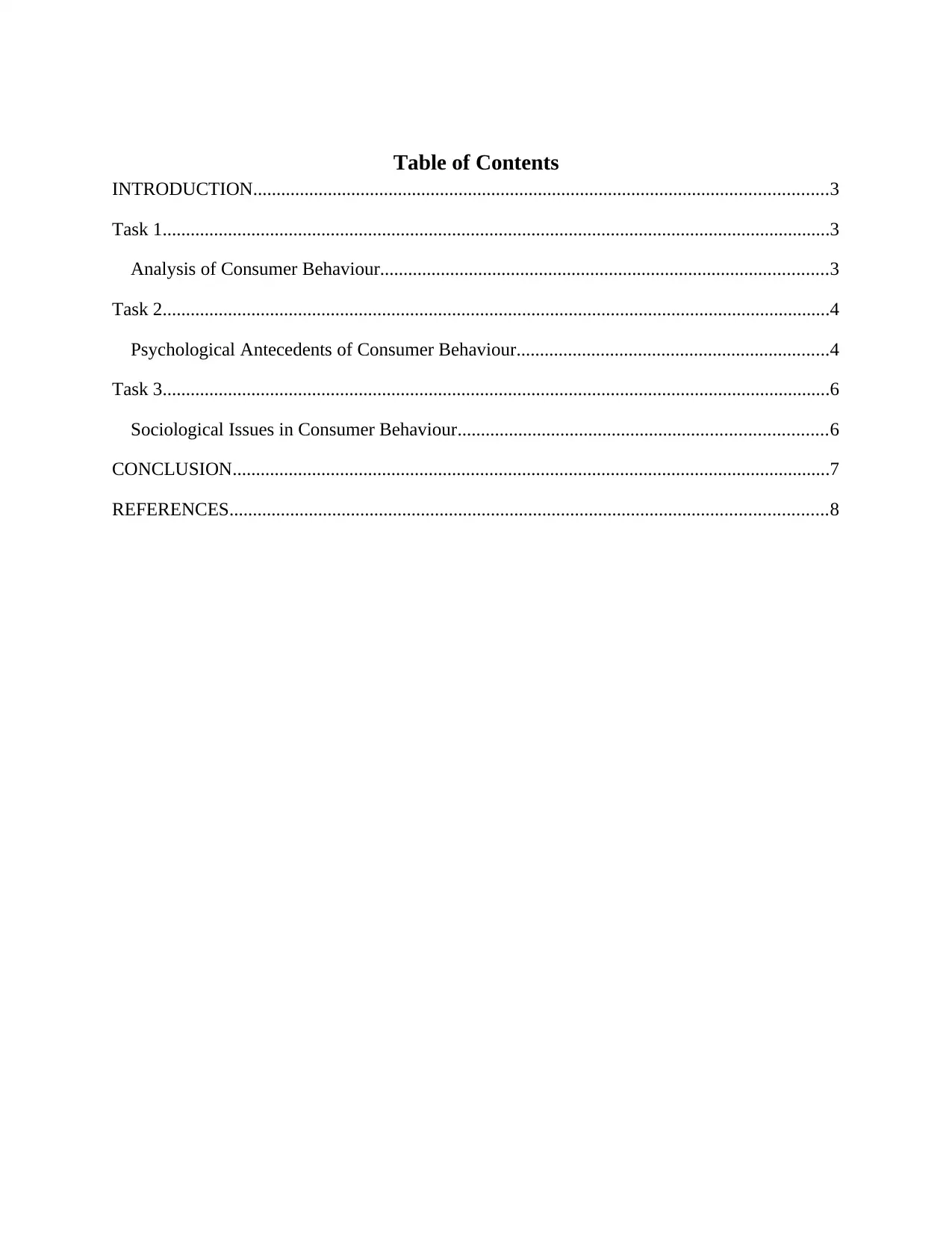
Table of Contents
INTRODUCTION...........................................................................................................................3
Task 1...............................................................................................................................................3
Analysis of Consumer Behaviour................................................................................................3
Task 2...............................................................................................................................................4
Psychological Antecedents of Consumer Behaviour...................................................................4
Task 3...............................................................................................................................................6
Sociological Issues in Consumer Behaviour...............................................................................6
CONCLUSION................................................................................................................................7
REFERENCES................................................................................................................................8
INTRODUCTION...........................................................................................................................3
Task 1...............................................................................................................................................3
Analysis of Consumer Behaviour................................................................................................3
Task 2...............................................................................................................................................4
Psychological Antecedents of Consumer Behaviour...................................................................4
Task 3...............................................................................................................................................6
Sociological Issues in Consumer Behaviour...............................................................................6
CONCLUSION................................................................................................................................7
REFERENCES................................................................................................................................8
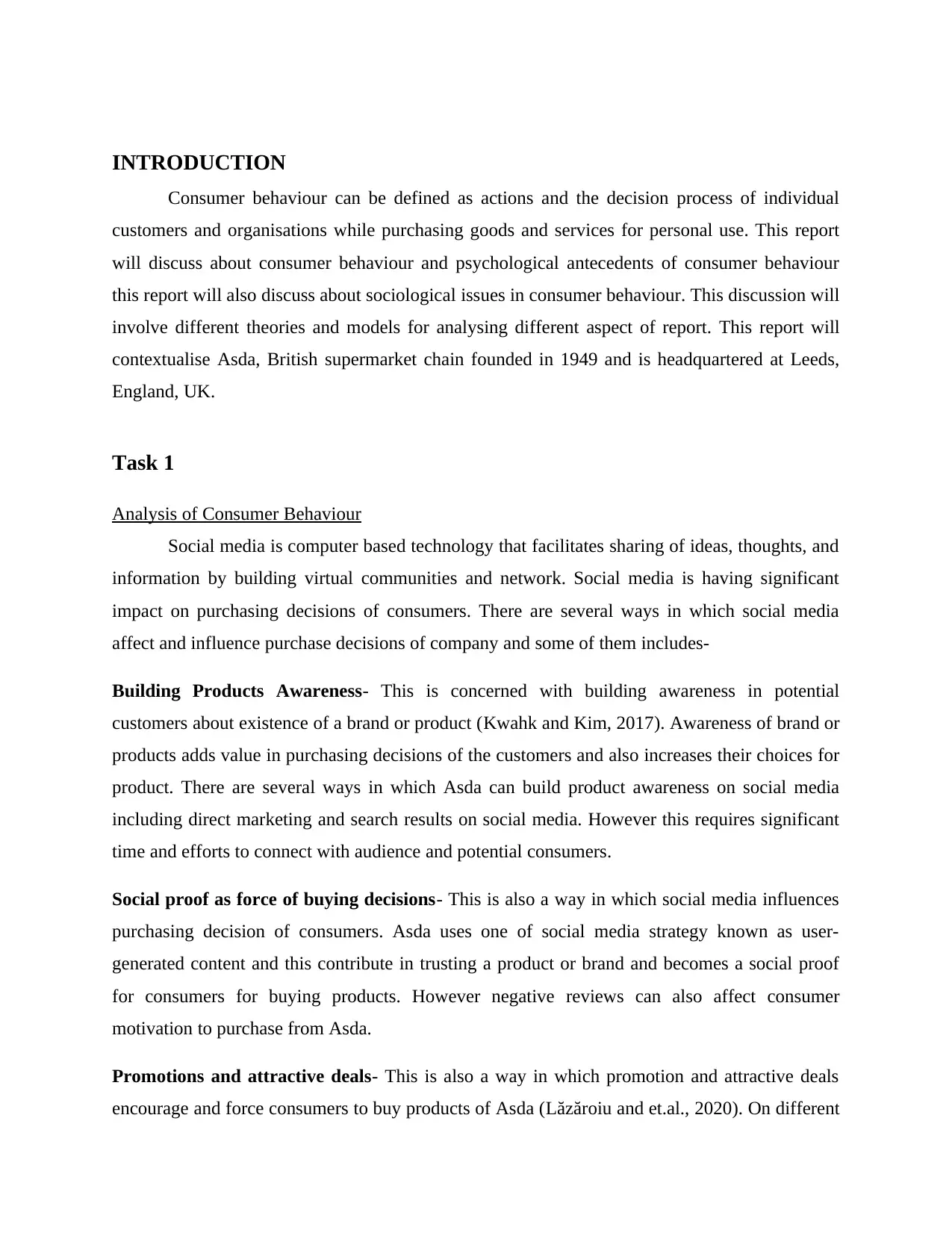
INTRODUCTION
Consumer behaviour can be defined as actions and the decision process of individual
customers and organisations while purchasing goods and services for personal use. This report
will discuss about consumer behaviour and psychological antecedents of consumer behaviour
this report will also discuss about sociological issues in consumer behaviour. This discussion will
involve different theories and models for analysing different aspect of report. This report will
contextualise Asda, British supermarket chain founded in 1949 and is headquartered at Leeds,
England, UK.
Task 1
Analysis of Consumer Behaviour
Social media is computer based technology that facilitates sharing of ideas, thoughts, and
information by building virtual communities and network. Social media is having significant
impact on purchasing decisions of consumers. There are several ways in which social media
affect and influence purchase decisions of company and some of them includes-
Building Products Awareness- This is concerned with building awareness in potential
customers about existence of a brand or product (Kwahk and Kim, 2017). Awareness of brand or
products adds value in purchasing decisions of the customers and also increases their choices for
product. There are several ways in which Asda can build product awareness on social media
including direct marketing and search results on social media. However this requires significant
time and efforts to connect with audience and potential consumers.
Social proof as force of buying decisions- This is also a way in which social media influences
purchasing decision of consumers. Asda uses one of social media strategy known as user-
generated content and this contribute in trusting a product or brand and becomes a social proof
for consumers for buying products. However negative reviews can also affect consumer
motivation to purchase from Asda.
Promotions and attractive deals- This is also a way in which promotion and attractive deals
encourage and force consumers to buy products of Asda (Lăzăroiu and et.al., 2020). On different
Consumer behaviour can be defined as actions and the decision process of individual
customers and organisations while purchasing goods and services for personal use. This report
will discuss about consumer behaviour and psychological antecedents of consumer behaviour
this report will also discuss about sociological issues in consumer behaviour. This discussion will
involve different theories and models for analysing different aspect of report. This report will
contextualise Asda, British supermarket chain founded in 1949 and is headquartered at Leeds,
England, UK.
Task 1
Analysis of Consumer Behaviour
Social media is computer based technology that facilitates sharing of ideas, thoughts, and
information by building virtual communities and network. Social media is having significant
impact on purchasing decisions of consumers. There are several ways in which social media
affect and influence purchase decisions of company and some of them includes-
Building Products Awareness- This is concerned with building awareness in potential
customers about existence of a brand or product (Kwahk and Kim, 2017). Awareness of brand or
products adds value in purchasing decisions of the customers and also increases their choices for
product. There are several ways in which Asda can build product awareness on social media
including direct marketing and search results on social media. However this requires significant
time and efforts to connect with audience and potential consumers.
Social proof as force of buying decisions- This is also a way in which social media influences
purchasing decision of consumers. Asda uses one of social media strategy known as user-
generated content and this contribute in trusting a product or brand and becomes a social proof
for consumers for buying products. However negative reviews can also affect consumer
motivation to purchase from Asda.
Promotions and attractive deals- This is also a way in which promotion and attractive deals
encourage and force consumers to buy products of Asda (Lăzăroiu and et.al., 2020). On different
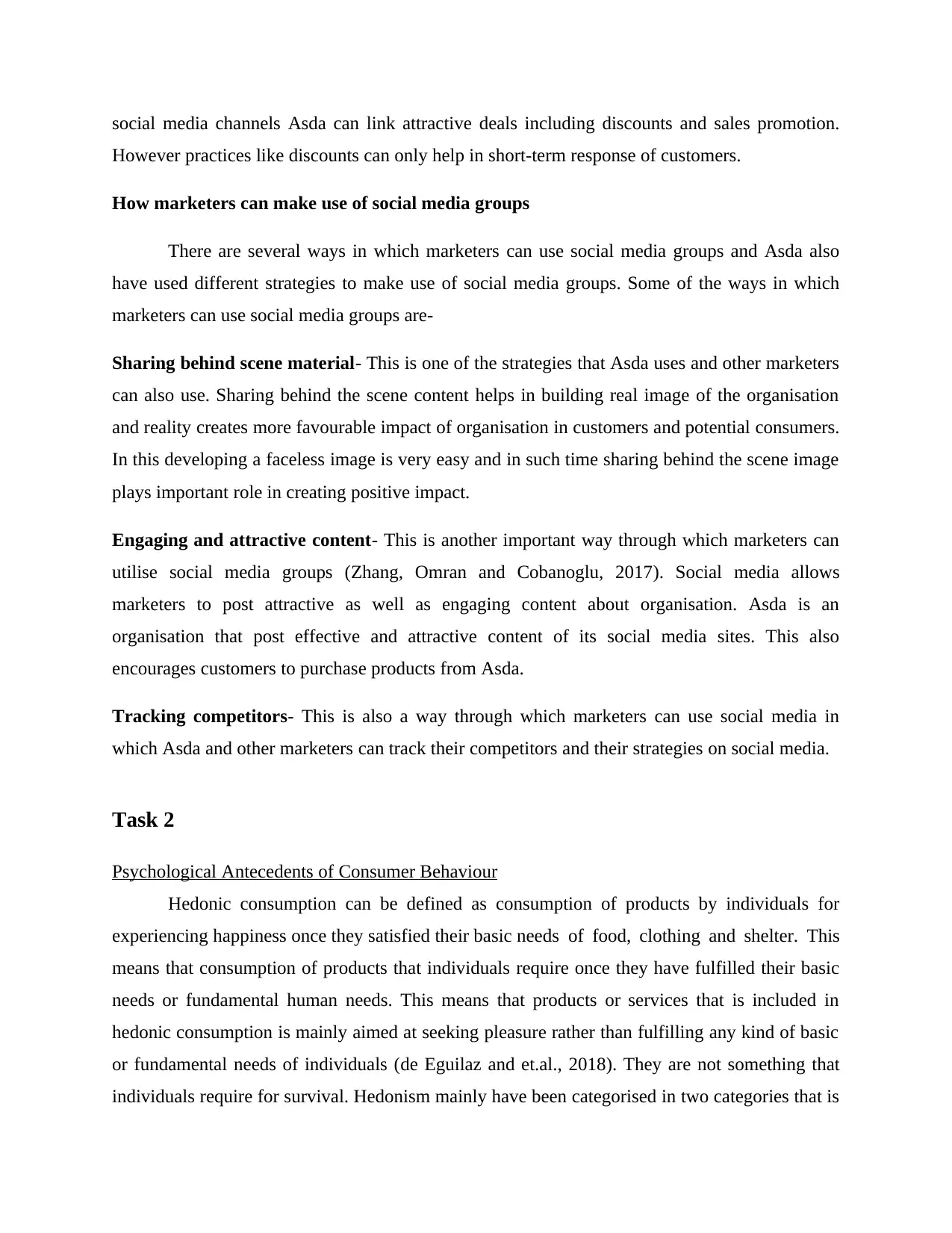
social media channels Asda can link attractive deals including discounts and sales promotion.
However practices like discounts can only help in short-term response of customers.
How marketers can make use of social media groups
There are several ways in which marketers can use social media groups and Asda also
have used different strategies to make use of social media groups. Some of the ways in which
marketers can use social media groups are-
Sharing behind scene material- This is one of the strategies that Asda uses and other marketers
can also use. Sharing behind the scene content helps in building real image of the organisation
and reality creates more favourable impact of organisation in customers and potential consumers.
In this developing a faceless image is very easy and in such time sharing behind the scene image
plays important role in creating positive impact.
Engaging and attractive content- This is another important way through which marketers can
utilise social media groups (Zhang, Omran and Cobanoglu, 2017). Social media allows
marketers to post attractive as well as engaging content about organisation. Asda is an
organisation that post effective and attractive content of its social media sites. This also
encourages customers to purchase products from Asda.
Tracking competitors- This is also a way through which marketers can use social media in
which Asda and other marketers can track their competitors and their strategies on social media.
Task 2
Psychological Antecedents of Consumer Behaviour
Hedonic consumption can be defined as consumption of products by individuals for
experiencing happiness once they satisfied their basic needs of food, clothing and shelter. This
means that consumption of products that individuals require once they have fulfilled their basic
needs or fundamental human needs. This means that products or services that is included in
hedonic consumption is mainly aimed at seeking pleasure rather than fulfilling any kind of basic
or fundamental needs of individuals (de Eguilaz and et.al., 2018). They are not something that
individuals require for survival. Hedonism mainly have been categorised in two categories that is
However practices like discounts can only help in short-term response of customers.
How marketers can make use of social media groups
There are several ways in which marketers can use social media groups and Asda also
have used different strategies to make use of social media groups. Some of the ways in which
marketers can use social media groups are-
Sharing behind scene material- This is one of the strategies that Asda uses and other marketers
can also use. Sharing behind the scene content helps in building real image of the organisation
and reality creates more favourable impact of organisation in customers and potential consumers.
In this developing a faceless image is very easy and in such time sharing behind the scene image
plays important role in creating positive impact.
Engaging and attractive content- This is another important way through which marketers can
utilise social media groups (Zhang, Omran and Cobanoglu, 2017). Social media allows
marketers to post attractive as well as engaging content about organisation. Asda is an
organisation that post effective and attractive content of its social media sites. This also
encourages customers to purchase products from Asda.
Tracking competitors- This is also a way through which marketers can use social media in
which Asda and other marketers can track their competitors and their strategies on social media.
Task 2
Psychological Antecedents of Consumer Behaviour
Hedonic consumption can be defined as consumption of products by individuals for
experiencing happiness once they satisfied their basic needs of food, clothing and shelter. This
means that consumption of products that individuals require once they have fulfilled their basic
needs or fundamental human needs. This means that products or services that is included in
hedonic consumption is mainly aimed at seeking pleasure rather than fulfilling any kind of basic
or fundamental needs of individuals (de Eguilaz and et.al., 2018). They are not something that
individuals require for survival. Hedonism mainly have been categorised in two categories that is
Secure Best Marks with AI Grader
Need help grading? Try our AI Grader for instant feedback on your assignments.
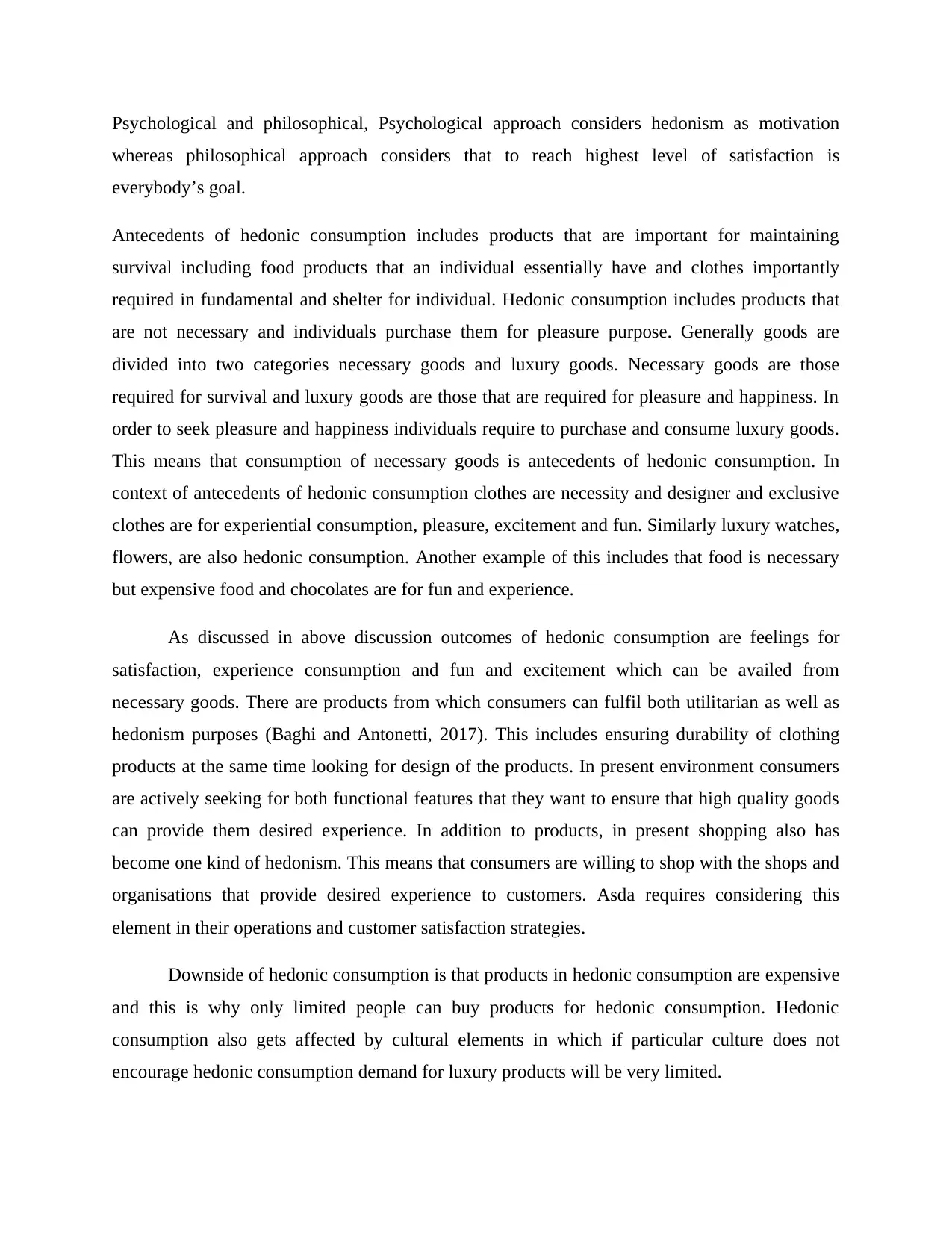
Psychological and philosophical, Psychological approach considers hedonism as motivation
whereas philosophical approach considers that to reach highest level of satisfaction is
everybody’s goal.
Antecedents of hedonic consumption includes products that are important for maintaining
survival including food products that an individual essentially have and clothes importantly
required in fundamental and shelter for individual. Hedonic consumption includes products that
are not necessary and individuals purchase them for pleasure purpose. Generally goods are
divided into two categories necessary goods and luxury goods. Necessary goods are those
required for survival and luxury goods are those that are required for pleasure and happiness. In
order to seek pleasure and happiness individuals require to purchase and consume luxury goods.
This means that consumption of necessary goods is antecedents of hedonic consumption. In
context of antecedents of hedonic consumption clothes are necessity and designer and exclusive
clothes are for experiential consumption, pleasure, excitement and fun. Similarly luxury watches,
flowers, are also hedonic consumption. Another example of this includes that food is necessary
but expensive food and chocolates are for fun and experience.
As discussed in above discussion outcomes of hedonic consumption are feelings for
satisfaction, experience consumption and fun and excitement which can be availed from
necessary goods. There are products from which consumers can fulfil both utilitarian as well as
hedonism purposes (Baghi and Antonetti, 2017). This includes ensuring durability of clothing
products at the same time looking for design of the products. In present environment consumers
are actively seeking for both functional features that they want to ensure that high quality goods
can provide them desired experience. In addition to products, in present shopping also has
become one kind of hedonism. This means that consumers are willing to shop with the shops and
organisations that provide desired experience to customers. Asda requires considering this
element in their operations and customer satisfaction strategies.
Downside of hedonic consumption is that products in hedonic consumption are expensive
and this is why only limited people can buy products for hedonic consumption. Hedonic
consumption also gets affected by cultural elements in which if particular culture does not
encourage hedonic consumption demand for luxury products will be very limited.
whereas philosophical approach considers that to reach highest level of satisfaction is
everybody’s goal.
Antecedents of hedonic consumption includes products that are important for maintaining
survival including food products that an individual essentially have and clothes importantly
required in fundamental and shelter for individual. Hedonic consumption includes products that
are not necessary and individuals purchase them for pleasure purpose. Generally goods are
divided into two categories necessary goods and luxury goods. Necessary goods are those
required for survival and luxury goods are those that are required for pleasure and happiness. In
order to seek pleasure and happiness individuals require to purchase and consume luxury goods.
This means that consumption of necessary goods is antecedents of hedonic consumption. In
context of antecedents of hedonic consumption clothes are necessity and designer and exclusive
clothes are for experiential consumption, pleasure, excitement and fun. Similarly luxury watches,
flowers, are also hedonic consumption. Another example of this includes that food is necessary
but expensive food and chocolates are for fun and experience.
As discussed in above discussion outcomes of hedonic consumption are feelings for
satisfaction, experience consumption and fun and excitement which can be availed from
necessary goods. There are products from which consumers can fulfil both utilitarian as well as
hedonism purposes (Baghi and Antonetti, 2017). This includes ensuring durability of clothing
products at the same time looking for design of the products. In present environment consumers
are actively seeking for both functional features that they want to ensure that high quality goods
can provide them desired experience. In addition to products, in present shopping also has
become one kind of hedonism. This means that consumers are willing to shop with the shops and
organisations that provide desired experience to customers. Asda requires considering this
element in their operations and customer satisfaction strategies.
Downside of hedonic consumption is that products in hedonic consumption are expensive
and this is why only limited people can buy products for hedonic consumption. Hedonic
consumption also gets affected by cultural elements in which if particular culture does not
encourage hedonic consumption demand for luxury products will be very limited.
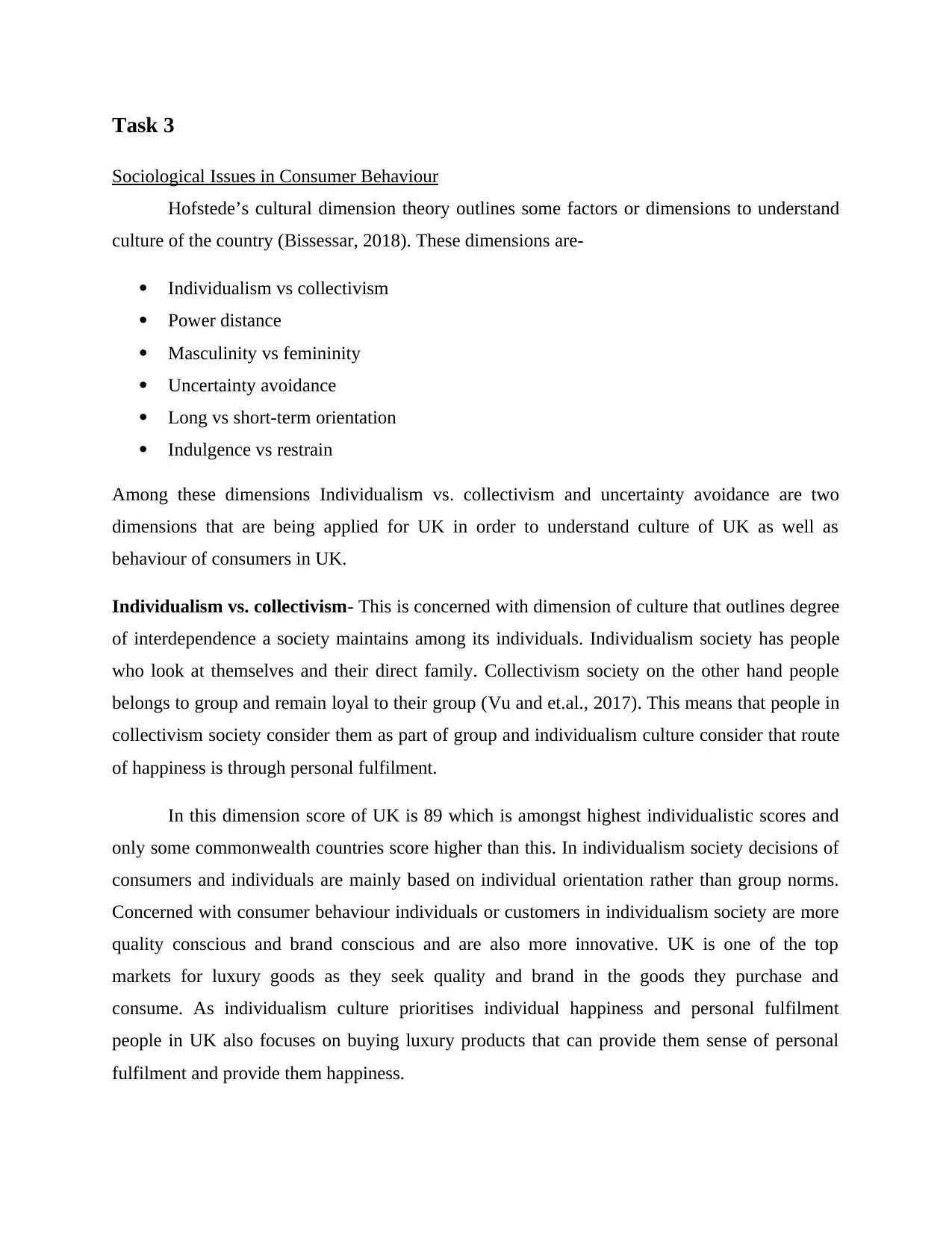
Task 3
Sociological Issues in Consumer Behaviour
Hofstede’s cultural dimension theory outlines some factors or dimensions to understand
culture of the country (Bissessar, 2018). These dimensions are-
Individualism vs collectivism
Power distance
Masculinity vs femininity
Uncertainty avoidance
Long vs short-term orientation
Indulgence vs restrain
Among these dimensions Individualism vs. collectivism and uncertainty avoidance are two
dimensions that are being applied for UK in order to understand culture of UK as well as
behaviour of consumers in UK.
Individualism vs. collectivism- This is concerned with dimension of culture that outlines degree
of interdependence a society maintains among its individuals. Individualism society has people
who look at themselves and their direct family. Collectivism society on the other hand people
belongs to group and remain loyal to their group (Vu and et.al., 2017). This means that people in
collectivism society consider them as part of group and individualism culture consider that route
of happiness is through personal fulfilment.
In this dimension score of UK is 89 which is amongst highest individualistic scores and
only some commonwealth countries score higher than this. In individualism society decisions of
consumers and individuals are mainly based on individual orientation rather than group norms.
Concerned with consumer behaviour individuals or customers in individualism society are more
quality conscious and brand conscious and are also more innovative. UK is one of the top
markets for luxury goods as they seek quality and brand in the goods they purchase and
consume. As individualism culture prioritises individual happiness and personal fulfilment
people in UK also focuses on buying luxury products that can provide them sense of personal
fulfilment and provide them happiness.
Sociological Issues in Consumer Behaviour
Hofstede’s cultural dimension theory outlines some factors or dimensions to understand
culture of the country (Bissessar, 2018). These dimensions are-
Individualism vs collectivism
Power distance
Masculinity vs femininity
Uncertainty avoidance
Long vs short-term orientation
Indulgence vs restrain
Among these dimensions Individualism vs. collectivism and uncertainty avoidance are two
dimensions that are being applied for UK in order to understand culture of UK as well as
behaviour of consumers in UK.
Individualism vs. collectivism- This is concerned with dimension of culture that outlines degree
of interdependence a society maintains among its individuals. Individualism society has people
who look at themselves and their direct family. Collectivism society on the other hand people
belongs to group and remain loyal to their group (Vu and et.al., 2017). This means that people in
collectivism society consider them as part of group and individualism culture consider that route
of happiness is through personal fulfilment.
In this dimension score of UK is 89 which is amongst highest individualistic scores and
only some commonwealth countries score higher than this. In individualism society decisions of
consumers and individuals are mainly based on individual orientation rather than group norms.
Concerned with consumer behaviour individuals or customers in individualism society are more
quality conscious and brand conscious and are also more innovative. UK is one of the top
markets for luxury goods as they seek quality and brand in the goods they purchase and
consume. As individualism culture prioritises individual happiness and personal fulfilment
people in UK also focuses on buying luxury products that can provide them sense of personal
fulfilment and provide them happiness.
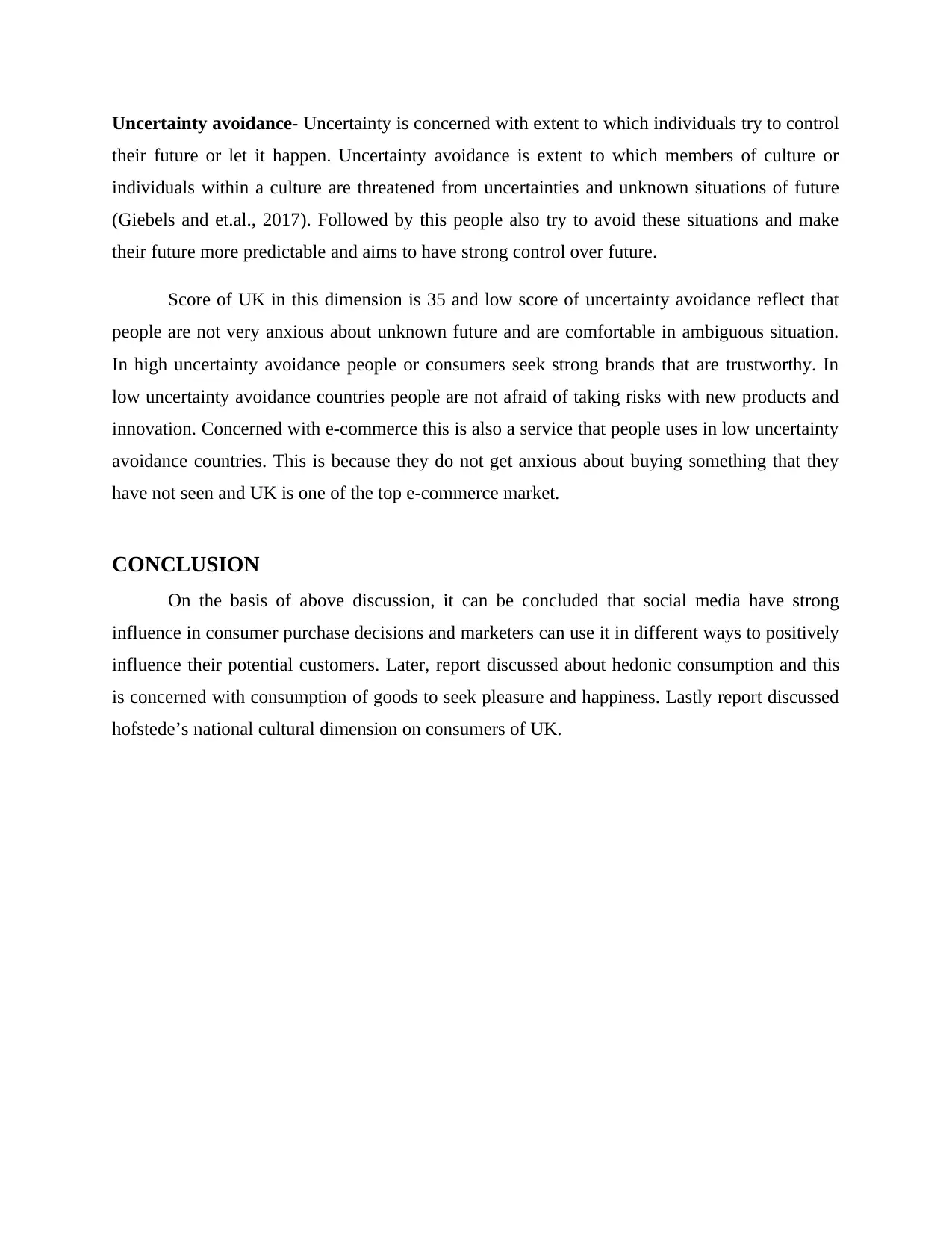
Uncertainty avoidance- Uncertainty is concerned with extent to which individuals try to control
their future or let it happen. Uncertainty avoidance is extent to which members of culture or
individuals within a culture are threatened from uncertainties and unknown situations of future
(Giebels and et.al., 2017). Followed by this people also try to avoid these situations and make
their future more predictable and aims to have strong control over future.
Score of UK in this dimension is 35 and low score of uncertainty avoidance reflect that
people are not very anxious about unknown future and are comfortable in ambiguous situation.
In high uncertainty avoidance people or consumers seek strong brands that are trustworthy. In
low uncertainty avoidance countries people are not afraid of taking risks with new products and
innovation. Concerned with e-commerce this is also a service that people uses in low uncertainty
avoidance countries. This is because they do not get anxious about buying something that they
have not seen and UK is one of the top e-commerce market.
CONCLUSION
On the basis of above discussion, it can be concluded that social media have strong
influence in consumer purchase decisions and marketers can use it in different ways to positively
influence their potential customers. Later, report discussed about hedonic consumption and this
is concerned with consumption of goods to seek pleasure and happiness. Lastly report discussed
hofstede’s national cultural dimension on consumers of UK.
their future or let it happen. Uncertainty avoidance is extent to which members of culture or
individuals within a culture are threatened from uncertainties and unknown situations of future
(Giebels and et.al., 2017). Followed by this people also try to avoid these situations and make
their future more predictable and aims to have strong control over future.
Score of UK in this dimension is 35 and low score of uncertainty avoidance reflect that
people are not very anxious about unknown future and are comfortable in ambiguous situation.
In high uncertainty avoidance people or consumers seek strong brands that are trustworthy. In
low uncertainty avoidance countries people are not afraid of taking risks with new products and
innovation. Concerned with e-commerce this is also a service that people uses in low uncertainty
avoidance countries. This is because they do not get anxious about buying something that they
have not seen and UK is one of the top e-commerce market.
CONCLUSION
On the basis of above discussion, it can be concluded that social media have strong
influence in consumer purchase decisions and marketers can use it in different ways to positively
influence their potential customers. Later, report discussed about hedonic consumption and this
is concerned with consumption of goods to seek pleasure and happiness. Lastly report discussed
hofstede’s national cultural dimension on consumers of UK.
Paraphrase This Document
Need a fresh take? Get an instant paraphrase of this document with our AI Paraphraser
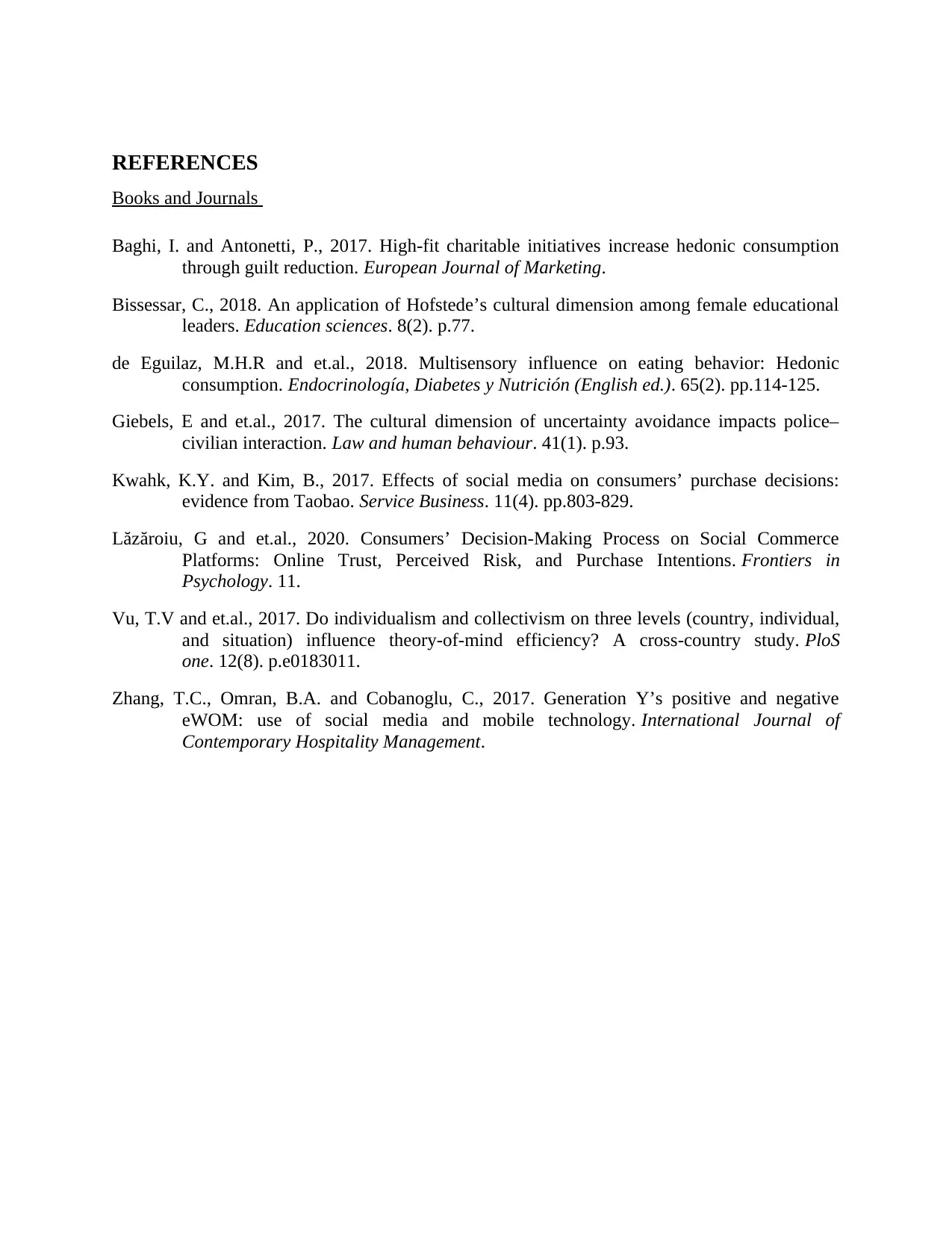
REFERENCES
Books and Journals
Baghi, I. and Antonetti, P., 2017. High-fit charitable initiatives increase hedonic consumption
through guilt reduction. European Journal of Marketing.
Bissessar, C., 2018. An application of Hofstede’s cultural dimension among female educational
leaders. Education sciences. 8(2). p.77.
de Eguilaz, M.H.R and et.al., 2018. Multisensory influence on eating behavior: Hedonic
consumption. Endocrinología, Diabetes y Nutrición (English ed.). 65(2). pp.114-125.
Giebels, E and et.al., 2017. The cultural dimension of uncertainty avoidance impacts police–
civilian interaction. Law and human behaviour. 41(1). p.93.
Kwahk, K.Y. and Kim, B., 2017. Effects of social media on consumers’ purchase decisions:
evidence from Taobao. Service Business. 11(4). pp.803-829.
Lăzăroiu, G and et.al., 2020. Consumers’ Decision-Making Process on Social Commerce
Platforms: Online Trust, Perceived Risk, and Purchase Intentions. Frontiers in
Psychology. 11.
Vu, T.V and et.al., 2017. Do individualism and collectivism on three levels (country, individual,
and situation) influence theory-of-mind efficiency? A cross-country study. PloS
one. 12(8). p.e0183011.
Zhang, T.C., Omran, B.A. and Cobanoglu, C., 2017. Generation Y’s positive and negative
eWOM: use of social media and mobile technology. International Journal of
Contemporary Hospitality Management.
Books and Journals
Baghi, I. and Antonetti, P., 2017. High-fit charitable initiatives increase hedonic consumption
through guilt reduction. European Journal of Marketing.
Bissessar, C., 2018. An application of Hofstede’s cultural dimension among female educational
leaders. Education sciences. 8(2). p.77.
de Eguilaz, M.H.R and et.al., 2018. Multisensory influence on eating behavior: Hedonic
consumption. Endocrinología, Diabetes y Nutrición (English ed.). 65(2). pp.114-125.
Giebels, E and et.al., 2017. The cultural dimension of uncertainty avoidance impacts police–
civilian interaction. Law and human behaviour. 41(1). p.93.
Kwahk, K.Y. and Kim, B., 2017. Effects of social media on consumers’ purchase decisions:
evidence from Taobao. Service Business. 11(4). pp.803-829.
Lăzăroiu, G and et.al., 2020. Consumers’ Decision-Making Process on Social Commerce
Platforms: Online Trust, Perceived Risk, and Purchase Intentions. Frontiers in
Psychology. 11.
Vu, T.V and et.al., 2017. Do individualism and collectivism on three levels (country, individual,
and situation) influence theory-of-mind efficiency? A cross-country study. PloS
one. 12(8). p.e0183011.
Zhang, T.C., Omran, B.A. and Cobanoglu, C., 2017. Generation Y’s positive and negative
eWOM: use of social media and mobile technology. International Journal of
Contemporary Hospitality Management.
1 out of 8
Related Documents
Your All-in-One AI-Powered Toolkit for Academic Success.
+13062052269
info@desklib.com
Available 24*7 on WhatsApp / Email
![[object Object]](/_next/static/media/star-bottom.7253800d.svg)
Unlock your academic potential
© 2024 | Zucol Services PVT LTD | All rights reserved.




